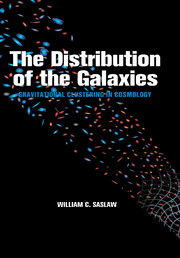Book contents
- Frontmatter
- Contents
- Prologue
- Part I Historical
- Part II Descriptions of Clustering
- Part III Gravity and Correlation Functions
- Part IV Gravity and Distribution Functions
- 21 General Properties of Distribution Functions
- 22 Dynamics of Distribution Functions
- 23 Short Review of Basic Thermodynamics
- 24 Thermodynamics and Gravity
- 25 Thermodynamic Formulation of the Cosmological Many-Body Problem
- 26 The Functional Form of b(n̄, T)
- 27 Derivation of the Spatial Distribution Function
- 28 Properties of the Spatial Gravitational Quasi-Equillibrium Distribution
- 29 The Velocity Distribution Function
- 30 Evolution of the GQED
- Part V Computer Experiments for Distribution Functions
- Part VI Observations of Distribution Functions
- Part VII Future Unfoldings
- Bibliography
- Index
24 - Thermodynamics and Gravity
Published online by Cambridge University Press: 19 January 2010
- Frontmatter
- Contents
- Prologue
- Part I Historical
- Part II Descriptions of Clustering
- Part III Gravity and Correlation Functions
- Part IV Gravity and Distribution Functions
- 21 General Properties of Distribution Functions
- 22 Dynamics of Distribution Functions
- 23 Short Review of Basic Thermodynamics
- 24 Thermodynamics and Gravity
- 25 Thermodynamic Formulation of the Cosmological Many-Body Problem
- 26 The Functional Form of b(n̄, T)
- 27 Derivation of the Spatial Distribution Function
- 28 Properties of the Spatial Gravitational Quasi-Equillibrium Distribution
- 29 The Velocity Distribution Function
- 30 Evolution of the GQED
- Part V Computer Experiments for Distribution Functions
- Part VI Observations of Distribution Functions
- Part VII Future Unfoldings
- Bibliography
- Index
Summary
I will not refrain from setting among these
precepts a new device for consideration which,
although it may appear trivial and almost
ludicrous, is nevertheless of great utility
in arousing the mind to various inventions.
Leonardo da VinciIn the past, there has been a widely held mythology that thermodynamics and gravity are incompatible. The main arguments for that view were threefold. First, thermodynamics applies to equilibrium systems. But self-gravitating systems continually evolve toward more singular states, so they are never in equilibrium. Second, to obtain a thermodynamic or statistical mechanical description it must be possible to calculate the partition function for the relevant ensemble, as in (23.60). But self-gravitating systems contain states where two objects can move arbitrarily close and contribute infinite negative gravitational energy, making the partition function diverge. Third, the fundamental parameters of thermodynamics must be extensive quantities. But self-gravitating systems cannot localize their potential energy in an isolated cell; it belongs to the whole system.
All three of these arguments have a common basis in the long-range nature of the gravitational force and the fact that it does not saturate. By contrast, in the electrostatic case of a plasma, although the Coulomb forces are also long range, the positive and negative charges effectively cancel on scales larger than a Debye sphere where the plasma is essentially neutral, and its net interaction energy is zero. So one can describe plasmas thermodynamically (e.g., Landau & Lifshitz, 1969).
- Type
- Chapter
- Information
- The Distribution of the GalaxiesGravitational Clustering in Cosmology, pp. 301 - 305Publisher: Cambridge University PressPrint publication year: 1999



